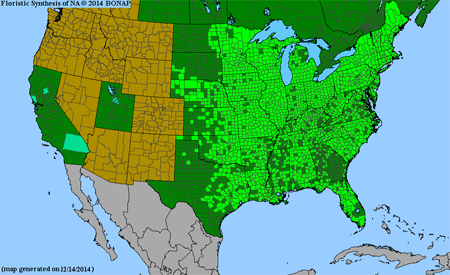Viola sororia [hirsutuloides variant]
Common names:
None.
Synonyms:
None.
Description:
Foliage, peduncles and calyx darker blue-green, with midrib, lower surface of leaf blades, petioles and calyx purple-tinged and glabrous throughout except for occasionally sparsely hirtellous petioles and scattered minute appressed hairs on the upper leaf blade surfaces that may require magnification to see; leaf blades ovate to suborbicular or reniform with base cordate and apex broadly rounded, margins uniformly shallowly crenate, eciliate; seeds unknown. Other features same as the species complex.
Ecology:
Loamy or silty loam soils in mesic and wet-mesic forests, on terraces along streams and rivers.
Distribution:
Appalachian highlands and adjacent uplands, perhaps roughly approximating the range of V. hirsutula; needs further study.
Rarity:
None.
Phenology:
Presumably same as the species complex.
Affinities:
Same as the species complex.
Hybrids:
Reports of hybrids involving "V. papilionacea" probably refer to this, V. communis, or V. sororia [glabrous variant] but most likely the latter two. They include V. affinis (Brainerd 1904b, 1924), V. brittoniana (Brainerd 1924), V. cucullata (Brainerd 1906b), V. emarginata (Brainerd 1924), V. fimbriatula (Brainerd 1904b, 1906b, 1924), V. hirsutula (Brainerd 1907a, 1924, Henry 1953a), possibly V. nephrophylla (Brainerd 1924), V. palmata var. triloba (Brainerd 1912, 1924), V. sagittata (Brainerd 1906b, 1924), V. sororia sensu stricto (Brainerd 1924, Henry 1953a), V. stoneana (Brainerd 1912, 1924), and V. subsinuata sensu stricto (Dowell 1910, Brainerd 1912, 1924). The actual parentage of these hybrids (with respect to which glabrous taxon was actually involved) needs to be established beyond doubt. Brainerd reported that these exhibit intermediate or recombinant characteristics of foliage, chasmogamous flowers, cleistogamous capsules and seeds (where these did not abort). All hybrids fail to reproduce by chasmogamous flowers, and the cleistogamous capsules are abortive or produce a drastically diminished proportion of viable seeds.
Comments:
Although this is a distinctive variant in the V. sororia complex, it remains poorly known and not very well represented in herbarium collections (presumably because it looks similar to V. sororia and is passed over as too common to collect). It often grows near or commingles with V. communis and V. sororia sensu stricto in southeastern Ohio, and sometimes appears to hybridize with those taxa, but it retains its distinctive morphological traits. Both V. communis and the present taxon are particularly well represented in the moist silty loamy soils of stream floodplains and low terraces in southeastern Ohio, but it ranges on higher ground elsewhere in its Appalachian upland range. Cleistogamous capsules and seeds have yet to be found and described. As with other variants, this needs further study.
Literature Cited:
None.

Map of the Viola sororia species complex by the Biota of North America Program